Dollar Princesses in Britain – The Glitter, Grit, and Gowns Behind ‘The Buccaneers’
Apple TV+’s glossy period drama The Buccaneers is back for a much-anticipated second season. It draws global audiences into a world of opulence, romance, and cultural clash. Though it dazzles with lavish visuals and aristocratic drama, the show draws directly from real history—specifically the story of dollar princesses in Britain. These wealthy American women, often from the Gilded Age elite, crossed the Atlantic in pursuit of titles, but ended up reshaping British high society itself.

Between the 1870s and the eve of World War I, over a hundred American women—many from New York’s rising elite—married into the British aristocracy. They didn’t just join it; they transformed it, bringing with them new energy, vast fortunes, and a bold sense of independence that challenged the old order.
Marriages of Money and Class: The Rise of Dollar Princesses in Britain
Writers coined the term “dollar princesses in Britain” to describe wealthy American women whose marriages to cash-strapped British aristocrats became iconic symbols of the Gilded Age. Though often viewed cynically as transactions—titles in exchange for fortunes—these alliances were more nuanced than mere financial arrangements. The dollar princesses in Britain didn’t simply trade money for status; they brought ambition, influence, and a new cultural energy to British high society.
According to historian Maureen Montgomery, an expert on Edith Wharton and the Gilded Age, the Great Agricultural Depression decimated traditional sources of aristocratic income. This forced many noble British families to seek financial salvation through marriage outside their social ranks. At the same time, dollar princesses in Britain—born to America’s industrial elite—were eager to gain the prestige of ancient titles that still held global sway.

Yet many dollar princesses in Britain didn’t enter marriage merely as part of a strategic business deal cloaked in lace and etiquette. Behind the gilded portraits were women of intellect, resolve, and often, emotional turmoil. Their stories reveal the complexity of lives lived between wealth and restriction, independence and expectation.
Dollar Princesses in Britain Who Challenged the Mold
Consuelo Vanderbilt, one of the most famous dollar princesses, became a reluctant symbol of this phenomenon. Her family forced her to marry the Duke of Marlborough to elevate their social status. She famously wept behind her veil on her wedding day. In her memoir The Glitter and the Gold, she describes a life of emotional isolation. Despite the splendor of Blenheim Palace—saved by her dowry—she found little happiness there.

In stark contrast was Daisy Leiter, the daughter of a Chicago magnate. Known for her independence and wit, Daisy chose her husband, the Earl of Suffolk, for love. Their union defied the stereotype of the dollar princess trapped in a loveless marriage. She later became one of the first female helicopter pilots—emblematic of the bold spirit many of these women possessed.
The Real Dollar Princesses in Britain Behind the Fiction
Edith Wharton, whose own social circle included both British aristocrats and American heiresses, began sketching out The Buccaneers in the 1920s. Real figures like Consuelo Vanderbilt and Consuelo Yznaga Montagu inspired her characters—strong, adventurous American women who challenged the constraints of old-world society.
The show’s showrunner, Katherine Jakeways, embraced the feminist and social themes embedded in Wharton’s draft. “What’s really interesting,” she says, “is that these women were far more educated and outspoken than their English counterparts.” In the United States, women were beginning to have social and intellectual agency. That confidence clashed, often explosively, with the rigid gender norms of Victorian England.
More Than Just ‘Gilded Prostitution’
The marriages provoked strong reactions across both sides of the Atlantic. British editor WT Stead famously referred to them as “gilded prostitution,” suggesting that women were selling themselves for titles while aristocrats sold their status for dollars. Even U.S. President Theodore Roosevelt decried the trend in 1906, lamenting that such unions diluted American values and drained its wealth.
Yet the story isn’t so one-sided. As Wendy Monkhouse, curator of Heiress: Sargent’s American Portraits at English Heritage, argues, these women weren’t just passive participants. “There was a real gutsiness about them,” she said. “They fought to earn acceptance in British high society—and they did it on their own terms.” Portraits of Power and Personality
John Singer Sargent, the portraitist of choice for the elite, immortalized many of these women. From the poised yet assertive Nancy Astor—America’s first woman to sit in the British Parliament—to the glamorous Cora, Countess of Strafford, Sargent’s brush captured not just beauty but personality.
His work is now celebrated in the Heiress exhibition at Kenwood House in London. Through these portraits, modern audiences can glimpse the charisma and complexity of the women who changed the face of the aristocracy.
A Legacy of Influence
The cultural impact of the dollar princesses stretches beyond fashion and marriage. They helped reshape perceptions of American women abroad. Their assertiveness, education, and philanthropic work often challenged the norms of British high society and led to long-term changes in attitudes towards women and foreigners.
Nancy Astor, for example, became a political force in her own right, holding her seat in Parliament for 25 years and influencing social reform debates. These women laid the groundwork for a transatlantic dialogue about class, gender, and identity that continues to resonate today.
Fiction Meets Reality
In The Buccaneers, fiction merges with history, but it also reclaims the agency of these women. The second season explores themes of power, politics, and identity as its characters evolve beyond the pursuit of love to embrace purpose and independence.
By drawing on stories like Consuelo Vanderbilt’s and Daisy Leiter’s, Jakeways gives the show’s characters modern relevance while honoring the trailblazing spirit of the original dollar princesses.
From Satire to Sisterhood
Originally satirized in the press and looked down upon by both British aristocrats and American elites, the dollar princesses are now recognized as complex historical figures. They weren’t just marrying up—they were breaking boundaries.
As public opinion shifts, so does the narrative. What once seemed like social climbing is now seen as cultural diplomacy, economic survival, and, in many cases, personal rebellion.
Will Their Story Continue?
With The Buccaneers season two continuing to charm viewers, the appetite for these stories seems stronger than ever. The show’s rich storytelling and deep historical inspiration have sparked renewed interest in the real women behind the fiction.

Will there be a season three? All signs point to yes. With its compelling blend of romance, social commentary, and historical intrigue, The Buccaneers has found a treasure trove of stories worth exploring—stories once buried beneath scandal, now celebrated for their audacity and vision.




